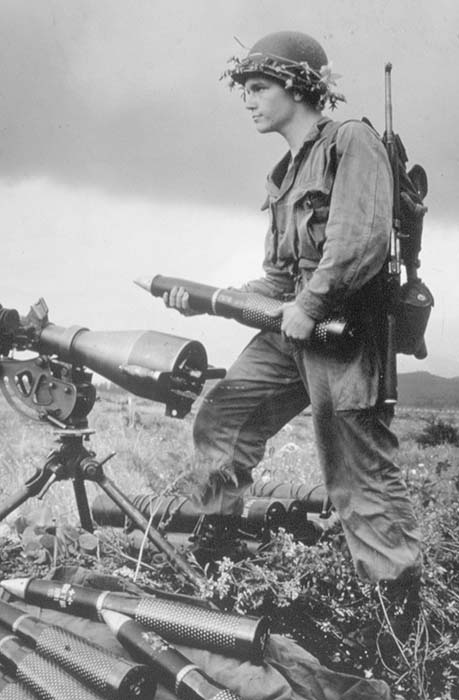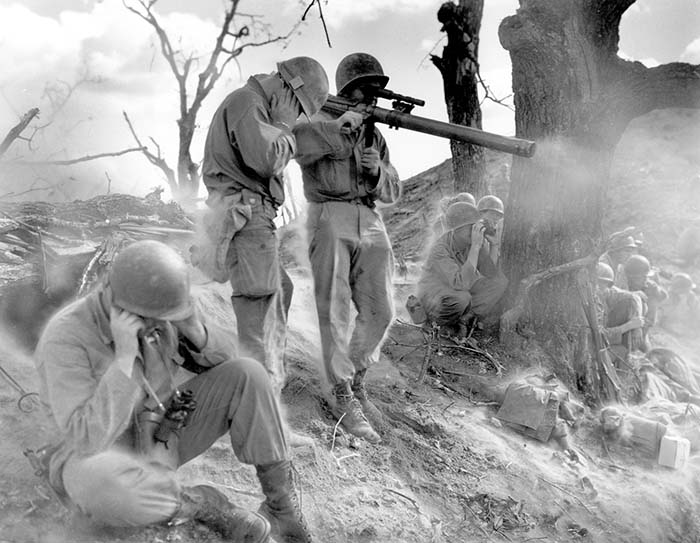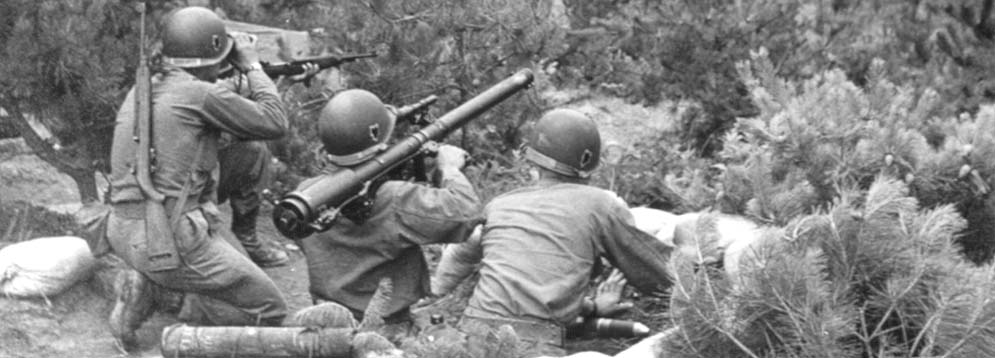August 1951, Munson-ni, Korea. A 57mm Recoilless Rifle team from the 27th Infantry Regiment “Wolfhounds” prepares to fire on an enemy position. This manportable artillery piece was particularly effective against dugouts and bunkers. Note also the carbines carried by two of the crewmen. Credit: SC/NA/RB
By Robert Bruce
“The introduction of the 3.5 inch bazooka in Korea occurred at a time when the main objective was to stop enemy armor. It proved effective in this use during a critical period. So the troops were won to it, and so being, tended to discount the worth of the 2.36 rocket launcher. Then came the phase when enemy armor was no longer a problem, and the prevailing tactical situation required the frequent destruction of large numbers of enemy personnel at close range as they attacked our hilltop perimeters. The 2.36 would have been a valuable adjunct of the infantry line at this point if used mainly as a man-killer.” Operations Research Office Report R-13, Oct 1951
The highly innovative “Bazooka” proved invaluable in the Korean War against enemy tanks and defensive emplacements. Introduced in a crash program during WWII, it had served exceptionally well as a remarkably effective weapon for infantry fighting in a variety of situations from anti-personnel to anti-tank engagements. When the initial 2.36 inch model proved inadequate against German armor, Army Ordnance essentially copied the bigger rocket from a captured enemy 8.8 cm PANZERSCHRECK (itself an improved version of one of the first American bazookas captured in Tunisia) and the M20 3.5 inch Rocket Launcher was born. What goes around, comes around….
At the end of WWII production of this new “Super Bazooka” was curtailed and, tragically, it was not available in sufficient numbers some five years later when Soviet-supplied T34 tanks first made their appearance in the Korean War. Numerous American units were overrun by these formidable battlewagons that, with the exception of a hit in the tracks or from above, were unstoppable by the little 2.36 in. launcher. The Army began a crash program to send all available 3.5’s to Korea and emergency contracts were signed to manufacture additional launchers and rockets.
“Sitting a little way up the slope from Watchel and the machine gun was Sgt. Paul West, with a 3.5 launcher in his lap…he raised the launcher and let go one rocket. His first round hit the Chinese mortar dead-on – at 225 yards range. It was the luckiest kind of a fluke shot. That cooled off the enemy force attacking up the draw.” ORO-R-13
Targets of Opportunity
Interestingly, combat reports showed that troops who had considered themselves highly fortunate to get the bigger bazooka, rarely used them against enemy infantry. This is puzzling, given that the standard high explosive anti-tank round was more powerful than that of a 60mm mortar, and the spectacularly effective white phosphorous rockets were in plentiful supply. Instead, the most common use of the 3.5 was mainly against machine guns, buildings where enemy skirmishers had taken cover, and occasionally for bunker-busting.
Recoilless Rifles
“…the basic idea of the recoilless rifle, which ranks with the bazooka as one of the most impressive ordnance developments of WWII…put artillery fire power in the hands of the individual foot soldier, for it required no ponderous carriage or recoil mechanism.” The Ordnance Department: Procurement and Supply

Only a hundred or so 57 and 75mm recoilless rifles had reached GIs in Europe in the last several weeks before Germany’s surrender, robbing these extraordinary weapons of honors they most surely would have won. Another bit of American reverse-engineering of an enemy weapon, in this case the 75mm L.G. 40 Recoilless Airborne Gun, it is similar in profile and employment to the bazooka, but operates on a completely different principle.
Instead of serving as merely a tube to point a rocket in the right direction, the recoilless rifle is a highly novel artillery piece that is light enough to make it readily man portable, yet fires powerful conventional projectiles. This bit of physics-defying magic is accomplished by perforating the walls of the cartridge case with large numbers of holes and placing the round in a partially open chamber with venturi tubes that allow escape of carefully calculated amounts of propellant gas.

On firing, sufficient pressure is built up to kick the round downrange at a serviceable velocity, but simultaneously, the rest is vented rearward. Thus, Newton’s Third Law Of Motion is not violated so the weapon does not recoil. The 57mm version can be readily shoulder fired, and the bigger 75mm is handled nicely on an ordinary machine gun tripod. Spin-stabilized by rifling inside the barrel, the projectile is fast and accurate both for direct fire and high angle employment at remarkable range.
No Free Lunch
On the negative side, this rearward venting of gas is extremely energetic and has some nasty side effects. First, there is a highly dangerous backblast area that must be kept clear of friendly troops and disallows firing from a bunker or backing up against a hillside. Also, its noise is painfully deafening and the nighttime firing signature is spectacularly bright. Finally, the weapons and their ammunition are significantly heavier than the bazooka, increasing the burden of the infantry unit struggling up and down the jagged ridges that characterized much of Korea’s terrain.
Balancing the equation, high explosive, anti-tank, and white phosphorous smoke ammunition was made for these unusual weapons, giving them roughly the same capabilities as the bazooka, mortar, and pack howitzer. The efficiency of this system was such that, in the peaceful years following WWII, recoilless rifles were thoroughly integrated into infantry tactical training and operations. And, most importantly to the scope of this article, both types were on hand and ready to go when the war in Korea began.
“Still, the companies will persist in carrying the 57mm [recoilless rifle forward in the hilltop fighting and will continue to use it futilely against targets which it cannot neutralize because of the distance, until at last they have one happy experience with the 75 on lower target ground against the same type of target. Then they adopt the weapon for good.” ORO-R-13
While there are numerous instances of recoilless rifles being used successfully against enemy armor, their most effective employment in Korea was undoubtedly in a long-range direct fire role against enemy defensive positions. North Korean and Chinese machine gun bunkers were a particular thorn in the side, hard to spot and even harder to take out.
Typically, these were deeply dug and reinforced with heavy timbers front and overhead so that only a direct hit from mortars or artillery would be sufficient to put them out of operation. Indeed, combat reports are full of frustrating instances where extended barrages, aerial delivery of bombs and rockets, and even smothering with napalm wouldn’t kill the dugout’s occupants.

But they were no match for the flat-trajectory and hard-hitting recoilless rifle firing on a line of sight from one ridgeline to another. Documented combat reports in ORO-R-13 unequivocally state that, “At ranges between 1000 and 1200 yards, the 75 recoilless is the only piece which can take them out under direct fire, with a relatively good chance of hitting dead on and destroying the object in one round; pack artillery might do it if it were available, but in its absence, the recoilless weapons are the main hope.”
Primary References
FM23-81 and FM 23-32 Brig. Gen. S.L.A. Marshall, “Commentary on Infantry Operations and Weapons Usage in Korea; Winter of 1950-51.” Johns Hopkins University, Operations Research Office Report ORO-R-13, Oct 27, 1951
| This article first appeared in Small Arms Review V4N12 (September 2001) |












